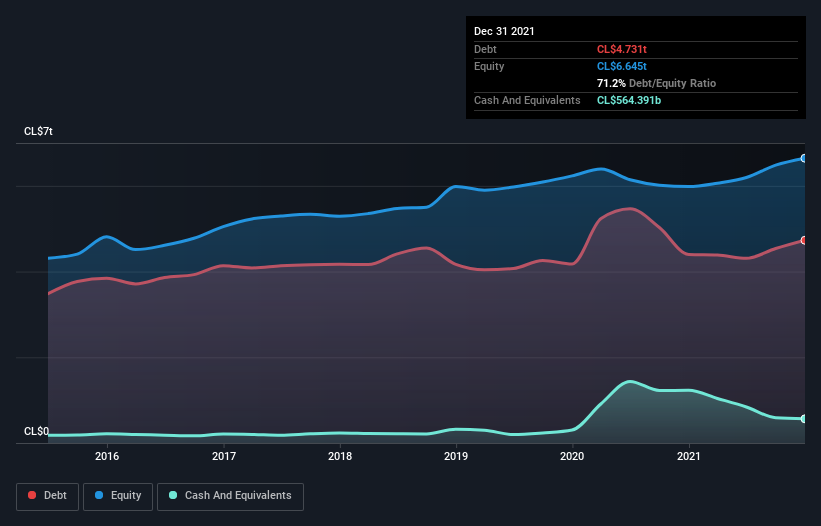- Chile
- /
- General Merchandise and Department Stores
- /
- SNSE:FALABELLA
These 4 Measures Indicate That Falabella (SNSE:FALABELLA) Is Using Debt Reasonably Well

The external fund manager backed by Berkshire Hathaway's Charlie Munger, Li Lu, makes no bones about it when he says 'The biggest investment risk is not the volatility of prices, but whether you will suffer a permanent loss of capital.' When we think about how risky a company is, we always like to look at its use of debt, since debt overload can lead to ruin. Importantly, Falabella S.A. (SNSE:FALABELLA) does carry debt. But the more important question is: how much risk is that debt creating?
Why Does Debt Bring Risk?
Debt assists a business until the business has trouble paying it off, either with new capital or with free cash flow. If things get really bad, the lenders can take control of the business. While that is not too common, we often do see indebted companies permanently diluting shareholders because lenders force them to raise capital at a distressed price. Of course, plenty of companies use debt to fund growth, without any negative consequences. The first thing to do when considering how much debt a business uses is to look at its cash and debt together.
See our latest analysis for Falabella
How Much Debt Does Falabella Carry?
You can click the graphic below for the historical numbers, but it shows that as of December 2021 Falabella had CL$4.73t of debt, an increase on CL$4.40t, over one year. However, it does have CL$564.4b in cash offsetting this, leading to net debt of about CL$4.17t.

How Strong Is Falabella's Balance Sheet?
We can see from the most recent balance sheet that Falabella had liabilities of CL$4.31t falling due within a year, and liabilities of CL$10t due beyond that. Offsetting this, it had CL$564.4b in cash and CL$462.3b in receivables that were due within 12 months. So its liabilities total CL$14t more than the combination of its cash and short-term receivables.
This deficit casts a shadow over the CL$5.82t company, like a colossus towering over mere mortals. So we'd watch its balance sheet closely, without a doubt. After all, Falabella would likely require a major re-capitalisation if it had to pay its creditors today.
In order to size up a company's debt relative to its earnings, we calculate its net debt divided by its earnings before interest, tax, depreciation, and amortization (EBITDA) and its earnings before interest and tax (EBIT) divided by its interest expense (its interest cover). Thus we consider debt relative to earnings both with and without depreciation and amortization expenses.
Falabella has a debt to EBITDA ratio of 2.9, which signals significant debt, but is still pretty reasonable for most types of business. However, its interest coverage of 10.2 is very high, suggesting that the interest expense on the debt is currently quite low. Notably, Falabella's EBIT launched higher than Elon Musk, gaining a whopping 204% on last year. The balance sheet is clearly the area to focus on when you are analysing debt. But ultimately the future profitability of the business will decide if Falabella can strengthen its balance sheet over time. So if you're focused on the future you can check out this free report showing analyst profit forecasts.
Finally, a business needs free cash flow to pay off debt; accounting profits just don't cut it. So we always check how much of that EBIT is translated into free cash flow. Happily for any shareholders, Falabella actually produced more free cash flow than EBIT over the last three years. That sort of strong cash generation warms our hearts like a puppy in a bumblebee suit.
Our View
Falabella's level of total liabilities was a real negative on this analysis, although the other factors we considered were considerably better. There's no doubt that its ability to to convert EBIT to free cash flow is pretty flash. Looking at all this data makes us feel a little cautious about Falabella's debt levels. While debt does have its upside in higher potential returns, we think shareholders should definitely consider how debt levels might make the stock more risky. There's no doubt that we learn most about debt from the balance sheet. However, not all investment risk resides within the balance sheet - far from it. Case in point: We've spotted 3 warning signs for Falabella you should be aware of, and 2 of them are significant.
At the end of the day, it's often better to focus on companies that are free from net debt. You can access our special list of such companies (all with a track record of profit growth). It's free.
New: AI Stock Screener & Alerts
Our new AI Stock Screener scans the market every day to uncover opportunities.
• Dividend Powerhouses (3%+ Yield)
• Undervalued Small Caps with Insider Buying
• High growth Tech and AI Companies
Or build your own from over 50 metrics.
Have feedback on this article? Concerned about the content? Get in touch with us directly. Alternatively, email editorial-team (at) simplywallst.com.
This article by Simply Wall St is general in nature. We provide commentary based on historical data and analyst forecasts only using an unbiased methodology and our articles are not intended to be financial advice. It does not constitute a recommendation to buy or sell any stock, and does not take account of your objectives, or your financial situation. We aim to bring you long-term focused analysis driven by fundamental data. Note that our analysis may not factor in the latest price-sensitive company announcements or qualitative material. Simply Wall St has no position in any stocks mentioned.
About SNSE:FALABELLA
Falabella
Engages in the retail sale of clothing, accessories, home products, electronics, and beauty and other products in Chile, Peru, Colombia, Brazil, Mexico, Uruguay, and Argentina.
Moderate growth potential with mediocre balance sheet.


